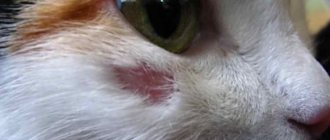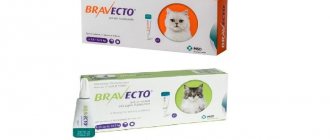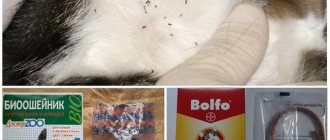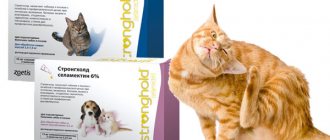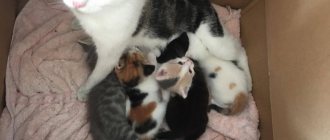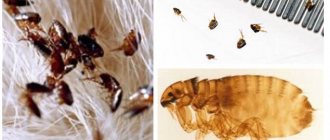Ringworm: symptoms and treatment at home
Ringworm does not manifest itself immediately; the incubation period can last up to three months. The first signs of the disease are the appearance of round spots without hair. At first the spots are small in size, but gradually they increase in size and occupy more and more surface area on the cat’s body.
Initially, lichen appears on the ears, face, tail and paws of the animal. With ringworm, the affected areas of the skin are covered with gray, oily scales.
The disease occurs in different forms. The easiest of them is superficial, the more complex and dangerous is the deep form of ringworm. It most often affects kittens, older cats and animals with weak immunity.
The third form of the disease is atypical. With this form of ringworm, isolated areas without hair form on the cat's body. What makes recognizing the disease difficult is that ringworm of this form can be confused with ordinary abrasions or abrasions.
The superficial form of lichen is also difficult to recognize, since upon external examination, especially if the cat is fluffy, the spots are not always easy to notice. Is there a cure for lichen in cats? Yes, and below we will look at how to do this.
Treatment
If your pet is at home almost all the time, this does not mean that the fungus is not scary for him.
Rather, on the contrary, in such cats the disease develops faster and is more difficult. How to cure cat ringworm? It is recommended to isolate a sick cat or limit its presence on a bed, sofa, or chair as much as possible. This must be done because lichen can spread to humans.
The first thing you need to do to treat a sick pet is to cut the hair near the affected area and treat the spots with brilliant green or iodine.
How to treat different types of lichen in cats
To answer the question of how to cure lichen in a cat and how to understand that the disease is going away, you need to understand the types of skin lesions. By knowing the specific forms of the disease, you can find out how long treatment should be carried out and when it is better to stop if the animal develops lichen.
Shearer
In medical terminology, this form of lichen is called dermatophytosis. Ringworm appears on the cat's head and begins to spread throughout the body. After the head, lichen appears on the ears, neck, then on the back and paws of the pet.
The more the cat scratches, the faster the shingles will spread. Ringworm of this form is treated with various antibacterial ointments, antifungal drugs and gels.
Weeping
Weeping lichen in cats is significantly different from ringworm. It is not contagious. In a kitten and an adult cat, the appearance of lichen may indicate a deterioration of immunity and a lack of vitamins in the body. Wet lichen manifests itself as eczema.
When the body is affected, reddish spots initially appear on the animal’s body. Gradually, bubbles filled with exudate grow in these places. If nothing is done, they will begin to burst and turn into abscesses. Ringworm of this form is treated with various ointments (sulfuric, salicylic acid, tar).
Pink
One of the most unstudied forms of lichen. Scientists cannot determine the reasons why pityriasis rosea appears. Most experts claim that this form of lichen occurs due to weakened animal immunity and allergic reactions.
It appears as small pink spots with flaky skin in the center. In order to cure a cat, you need to change its diet (change food), stop bathing it and treat the affected areas of the skin with apple cider vinegar.
How to treat tinea versicolor?
Weeping eczema is a disease caused by a malfunction of the cat's immune system.
Weeping eczema does not develop as a result of exposure to fungi; it is provoked by the following factors:
- External - the presence of parasites (ticks, fleas), exposure to detergents, lack of proper hygiene.
- Internal - disturbances in the functioning of the nervous system, hormonal imbalances, stress.
Symptoms
Symptoms of weeping eczema are painless red spots on the pet's skin with an increase in body temperature in areas of inflammation. Then such spots will be covered with dense blisters with exudative fluid.
As a result of properly selected treatment, such blisters can resolve, and if left untreated, they can open and become infected, resulting in the formation of ulcers.
After the ulcers rupture, the skin in the area of inflammation becomes moist. In turn, the correct approach to treatment and access of air to the inflammation contributes to the fact that the area of weeping lichen will quickly become covered with a crust, which will soon fall off in the form of scales.
Treatment
It is worth recognizing that weeping eczema in a cat is quite difficult to treat, so achieving a complete recovery can be difficult. However, the health of your four-legged friend is worth any effort!
So, what should you do if your cat has shingles? It is very important to consult a veterinarian before starting treatment, who will determine the cause of the development of this disease.
General recommendations in the treatment of weeping lichen may include the use of antiseptic and astringent agents that can significantly improve the cat’s skin in areas of inflammation. The following ointments have proven effective in the treatment of lichen: salicylic, ichthyol, sulfuric, tar, YaM ointment.
Ringworm remedies with unproven effectiveness
You can often come across the statement that “lichen is caused by poor immunity” and calls to “raise the immune system,” which boil down to administering immunomodulators and immunostimulants to the animal.
Immunity is a complex system of protecting the body from infectious agents - viruses, bacteria and fungi. There is general immunity and protective systems of individual organs and tissues, including the skin. Skin immunity is responsible for the rapid healing of wounds; it does not allow the causative agent of demodicosis, a mite of the genus Demodex, to multiply excessively, which is normally present in the skin of any animal, but causes the disease only with uncontrolled reproduction. This same system prevents ringworm infections by destroying the fungi as soon as the spores germinate. But it is much less effective when the mushrooms have already begun to multiply. General immunity, in turn, is not able to “reach” the upper layers of the epidermis and root parts of the hair, where microsporia pathogens live.
Immunostimulants and immunomodulators affect general immunity, which is in no way related to the incidence of ringworm. They cannot strengthen the skin's immune defense. And therefore, their use for microsporia in cats does not make sense.
Zinc ointment has a drying effect and was previously actively used to treat weeping eczema in humans and animals. It does not have an antifungal effect and in case of microsporia its use is pointless.
Sulfur ointment has a detrimental effect on scabies mites. It is ineffective against fungi and their spores, so its use for ringworm does not make sense.
YAM BK ointment has antifungal activity. However, its composition (sulfur, tar, creolin, turpentine) is very aggressive and can cause burns to the delicate skin of animals, and its antifungal effectiveness is much lower than that of modern antifungal drugs. Therefore, YAM is an outdated medicine that is not recommended for use in modern veterinary medicine for the treatment of microsporia and trichophytosis.
Treatment of pityriasis rosea
At the initial stage, pityriasis rosea in cats looks like a pink spot with clear boundaries and constant peeling. Constant itching causes great discomfort to the cat. In most cases, after a few days the pink spot will be covered with a dry crust.
Such spots tend to spread to other parts of the pet’s body.
Treatment
Since the development of pityriasis rosea is often associated with a decline in the cat's immune strength, treatment is focused on strengthening and maintaining the cat's immunity. Fortunately, this type of lichen does not require special treatment.
Often, all that is needed is to provide the cat with adequate nutrition, which would include a complex of microelements and vitamins. During the treatment of pink lichen, it is strictly forbidden to wash the animal. In addition, it is important to completely protect the cat from sunlight.
Over the course of 1-2 months, this type of lichen goes away on its own.
How to apply ointment correctly
To cure lichen in cats with sulfur ointment or any other composition, you must follow some rules:
- To prevent the lichen from spreading, it is necessary to close the cat in a small room. After using the medicine, the room must be disinfected.
- An animal diagnosed with lichen must not be allowed to come into contact with children and the elderly.
- You need to smear the cat while wearing rubber gloves.
- Before you begin to apply the medicinal ointment, you need to trim the hair around and on the affected area.
- Do not apply the medicine to flaky areas of the epidermis. The crusts are washed off with a damp cotton pad.
- The product is applied to the lichen and the skin around it.
- To cure lichen, you should take a comprehensive approach. To do this, you need to use ointments and tablets to boost immunity.
- Any hair that has been clipped from the affected area should be burned.
- To prevent the cat from licking the ointment, you need to put a special collar on it. It can be purchased at a veterinary store or pharmacy. Also, before starting the procedure, you need to treat all devices with an antiseptic.
Instructions for using the ointment for cats are contained in the package with the product. However, before applying it, it is advisable to contact a veterinarian so that a specialist can give advice and recommendations for treatment.
How to cure pityriasis versicolor?
Pityriasis versicolor is extremely contagious for both humans and other animals. It often begins as a small oval spot with a color that can range from pale yellow and pink to brown.
Subsequently, the spots quickly spread throughout the cat's body, merging together.
Treatment
Treatment of pityriasis versicolor requires a competent and responsible approach, therefore, if the first symptoms of the disease appear, you must urgently contact a veterinarian.
In the treatment of this type of lichen in cats, products containing enilconazole are used, for example, Imaverol. In severe cases, treatment of the cat with Lime Sulfur is prescribed.
Indications for use of ointments
For lichen and other skin diseases, various remedies can be used. In addition to these, to cure lichen, the veterinarian can prescribe tablets that boost the pet’s immunity.
The use of drugs against lichen in cats is possible only after determining the type of disease. To do this, you need to carefully monitor the cat’s condition and understand the symptoms that accompany lichen:
- the animal’s mood changes sharply, there is no appetite, playfulness disappears;
- the cat cannot sleep peacefully and stay in one place for a long time;
- The pet is bothered by itching of certain areas of the skin.
These are the first signs that may accompany lichen. If no action is taken, the situation may change to this state:
- The first obvious sign is the appearance of round or uneven spots without hair.
- The skin in the affected areas begins to dry and peel.
The spread of infection is facilitated by improper diet and scratching of the affected areas by the pet.
Ringworm ointment for cats: pros and cons
To cure lichen in a cat at home, you need to know which cream or ointment is best to choose. It is also worth considering the strengths and weaknesses of purchased funds. Advantages:
- The active ingredients of the ointment for lichen begin to work immediately after application to the affected areas of the skin. After the first application of the ointment, the infection will stop spreading quickly.
- The cat's condition improves. Itching and flaking disappear.
- The inflammatory process stops.
- Regeneration is accelerated.
- The remedy has an antibacterial effect.
Treat with home remedies
An alternative method of treating lichen in cats is the use of proven methods of traditional medicine. Despite the fact that they are less expensive, their effectiveness has been proven only in the early stages of the disease.
Their use is justified if there is no veterinary pharmacy nearby or there is no money to purchase pharmacological drugs.
How to treat lichen in cats at home? Consider popular recipes:
- Iodine. Treat the affected areas and the area around them with iodine or brilliant green twice a day.
- A mixture of olive oil and lemon juice. Mix the ingredients in equal proportions and heat slightly. Dip tampons into the medicinal mixture and apply to the affected areas 4 times a day.
- Celandine. Rub freshly squeezed celandine juice into the affected areas 4-5 times a day.
How to treat ringworm in cats at home
To choose an effective remedy for treating skin diseases in your pet, you need to take your cat to the veterinarian. The specialist will prescribe effective comprehensive treatment. Medications:
- Fungin for cats;
- Miramistin;
- Fukortsin for lichen for cats;
- Triderm;
- Akriderm;
- Chlorhexidine;
- Ivermek;
- Terbinafine;
- Fungin forte.
A very popular remedy is Fluconazole for cats against lichen, the dosage of which is selected by the veterinarian. Self-medication using medications is strictly prohibited. Otherwise, you can aggravate the situation and harm the cat.
The treatment regimen will directly depend on the form of the disease. Treatment products can be for external use (ointments, gels, aerosols, drops) or internal (capsules and liquid suspensions).
To quickly cope with a viral or fungal disease, immunomodulators and antibiotics are used.
At home, the affected areas can be smeared with iodine, potassium permanganate, grease and tar. When using these remedies, it is necessary to monitor the body's reaction. If your pet gets worse from using them, you should contact your veterinarian.
How to treat ringworm in a cat at home at the initial stage
If symptoms occur, treatment should be started immediately. In the first stages, you can do without medications.
You can use anti-lichen shampoos for cats, which are sold in any veterinary stores. Instructions for use and dosage are indicated on the shampoo packaging.
Anti-lichen sprays for cats (Fungin or Biopirox) are considered another effective remedy used to treat lichen in the early stages of the disease. It is enough to treat the affected areas of the cat’s skin with an aerosol twice a day until the general condition improves.
When treating the initial stage of lichen, it is not necessary to use potent compounds and drugs.
Getting rid of the disease in a generalized form
When standard medications are powerless and the disease continues to progress, it is necessary to begin more radical methods of treatment.
Getting rid of the disease in a generalized form
In the presence of multiple lesions of the skin, it should be recognized that the disease has developed into a generalized form.
At the same time, the affected areas make up more than half of the cat’s body, which means there is a risk of developing a secondary infection. That is why the generalized form of lichen requires very serious therapy - in addition to the use of ointments, sprays, and vaccinations, the doctor must prescribe antifungal medications and oral agents.
What are the best products to use?
After diagnosing a generalized form of the disease, the following medications for cats are prescribed for lichen:
- Itraconazole . A drug that suppresses the vital activity of most types of fungi. Since Itraconazole is toxic, the dosage must be adjusted by a veterinarian.
- Griseofulvin is a tablet that is aimed at suppressing fungi. This remedy helps the cat’s body replace the affected tissues with new ones as soon as possible. The drug is prescribed in combination with rubbing alcohol, iodine, as well as ointments for lichen. It is convenient to mix the product into animal feed.
Shampoo for kittens against ringworm and fleas
Some antifungal drugs are more effective against lichen, some less, it depends primarily on the general and local barrier immunity of the cat or kitten. Therefore, anti-lichen medications must be prescribed individually, because drugs that “work” in one animal may be ineffective in another. To treat cats from lichen, complex therapy is used, it is based on the use of different drugs: Preparations for local treatment (ointments, sprays, creams, shampoos, drops for lichen) Vaccines Oral medications (tablets for lichen for cats) Immunomodulators and vitamins
The use of folk remedies is ineffective against lichen in cats and kittens, especially in a generalized form. However, at the initial stage, the use of folk remedies is completely justified. Some folk remedies are harmful and dangerous for cats; you should not resort to traditional medicine when treating kittens and pregnant cats.
Smear the cat with brilliant green
, just like treating lichen
with iodine
is a useless exercise. Zelenka and iodine do not treat ringworm in cats. The use of caustic and toxic substances such as gasoline, sulfuric acid and other acids to treat lichen in a cat is strictly prohibited. Also among the popular folk remedies for lichen are: grease (smear 2-3 times a day, effect after 5 days), tar soap, sulfuric, salicylic and zinc ointments. They can treat the cat in its pure form. These remedies can be used to treat shingles in cats at an early stage.
Preparations for local treatment.
When using any external means on a cat or kitten, you need to wear a special plastic collar to avoid licking off the drug, this is important, since all drugs for the treatment of lichen are toxic.
Ointments, creams, sprays and drops against ringworm for cats and kittens.
1. “Fungin
” is an effective external remedy for lichen in cats. It contains clotrimazole and propolis. It has a wide spectrum of action on pathogenic and conditionally pathogenic fungi. Promotes healing of damaged tissues and reduces inflammatory processes.
Fungin is available in the form of drops and sprays against ringworm for cats. The drug is applied with a cotton pad to the affected areas, or sprayed with a spray once a day at a dose of 0.2 - 0.3 ml per 1 kg of body weight of a cat or kitten, for 10 - 15 days. Not recommended for pregnant or lactating cats. Although the product is effective, it is toxic; do not use it on severely weakened animals and do not exceed the dosage.
Judging by the reviews, Fungin for cats against lichen is quite effective, but there have been cases of kidney failure and death of animals, this can be explained by an overdose or licking of the drug.
2. “Clotrimazole
” is available in the form of tablets, ointment (cream 1%) and spray for topical use. Analogs: “Mikosporin”, “Clotrisal”, “Panmykol”. The ointment is used against pityriasis versicolor, ringworm (feline lichen) and other types of fungal diseases, and also has an antimicrobial effect. Clotrimazole is used to treat people, but based on reviews, it is effective in treating lichen in cats. The effect of the ointment does not appear immediately; symptoms may persist for 5-7 days, then gradual recovery occurs.
The cream is applied to the area affected by ringworm 2-3 times a day. The course of treatment, depending on the disease, ranges from 2 to 5 weeks. Do not use on pregnant or lactating cats.
3. ”Sanoderm
” – antifungal, anti-inflammatory, antibacterial drug for animals. The active ingredient is clotrimazole. The ointment is applied in a thin layer to the affected areas and gently rubbed in 2 times a day. If the cat's condition improves, Sanoderm can be applied once. The course of treatment is 2 – 4 weeks. Between repeated courses you need to take a break of 20 days. With prolonged use, suppression of adrenal function is possible.
4. ”YAM
” – a combined ointment with antifungal and acaricidal effects. It contains: salicylic acid, sulfur, tar, creolin, etc. YAM ointment is prescribed for dermatitis, eczema and lichen in cats. The ointment is applied in a thin layer 1 - 2 times a day, covering 2 - 4 cm around the affected areas, for 1 - 2 weeks. This ointment has the most affordable price, about 100 rubles. per jar. “YAM BK” ointment is a very toxic product, do not let the cat lick it, do not use it on small kittens, pregnant or lactating cats.
5. ”Miconazole
”has different release forms: tablets, cream, gel, anti-lichen spray for external use. Ointment 2% is effective against ringworm in cats and people. Has a bactericidal effect.
Miconozol should be rubbed onto the affected areas of the skin 2 times a day until all symptoms of lichen completely disappear and for prevention for another two days.
Miconazole is not recommended for use in combination with other ointments and creams. If there are no signs of improvement within three weeks, then it is better to stop using the drug. The ointment can only be used to treat adult cats.
6. ”Fucoricin
” is a combined drug with antiseptic and antifungal properties. Available in the form of a solution for external use. The composition includes phenol, fuchsin, boric acid, etc. Apply with a cotton swab 2 - 4 times a day. After Fucoricin has dried on the skin, additional medications can be applied in the form of ointment or cream. May cause allergic reactions in cats; with prolonged use it becomes addictive (stops working). Can only be used for small lesions of lichen in cats.
7. “Thermikon
” is available in the form of gel, cream, solution and spray for external use. Many people recommend Thermikon, a spray for treating lichen in cats. Before use, clean and dry the affected areas. Apply the cream or spray 1-2 times a day to the affected areas and rub in lightly. The course of treatment is 1 – 2 weeks. A decrease in the clinical manifestations of lichen is usually observed in the first days of treatment.
Prevention
To keep your cat healthy, you will need to follow these guidelines:
- When purchasing a new pet, it is necessary to thoroughly examine it.
- Regularly thoroughly clean furniture with a weak bleach solution, since many types of microorganisms and fungi are sensitive to it.
- Constantly clean and disinfect your cat's habitat.
- It is advisable to protect the cat from walking outside.
- Keep your pet away from other cats.
It is worth noting that for the most effective treatment of lichen in cats, it should be prescribed by a veterinarian after a thorough examination of the animal.



